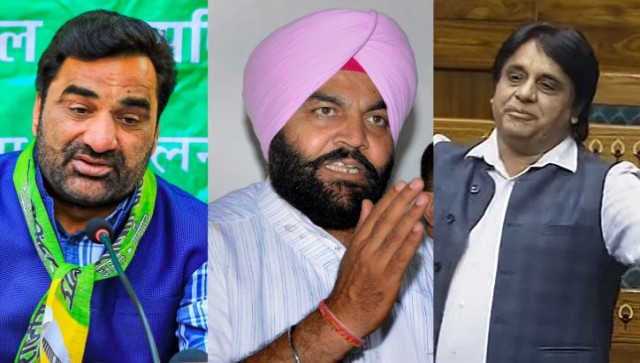The Bahujan Samaj Party (BSP) sacked two senior leaders for anti-party activities during the recently concluded Uttar Pradesh panchayat polls, a move that along with other ousters, is likely to hit the party’s chances in the upcoming Uttar Pradesh Assembly polls.
The ousting of Legislative Party Leader in the Uttar Pradesh Assembly Lalji Verma and another legislator Ram Achal Rajbhar, both ministers in the erstwhile Mayawati government, also comes after the BSP finished a distant third after the BJP and Samajwadi Party in the panchayat polls.
With the latest expulsions, the number of rebel BSP MLAs has increased to 11. The party had 19 MLAs in the incumbent Assembly.
Earlier this year, former BSP MLA Yogesh Verma joined the Akhilesh Yadav-led party along with wife Sunita Verma, the mayor of Meerut. Ramesh Chaudhary, a former professor at the department of history, Meerut University told India Today that Yogesh’s good hold on Dalit politics in western UP will strengthen the ‘cycle’ in the region.
A month later, on 19 February, BSP founding member RK Chaudhary defected to the Samajwadi Party.
Though both Verma and Rajbhar, who have reportedly been in touch with Samajwadi Party for the last few months, have reiterated their intent to stay with the BSP, their expulsion points to trouble in the party’s planning room.
Aslam Raini, one of the 11 rebel legislators who was suspended by party chief Mayawati for rebellion during the 2020 Rajya Sabha polls, blamed national general secretary Satish Chandra Mishra for repeated expulsion and suspension of senior leaders, reported News18 .
He dubbed it as the end of the party that was in power in Uttar Pradesh between 2007 and 2012.
Where is Mayawati?
Opposition parties and experts blame Mayawati for the dwindling fortunes of the party. According to them, the former Uttar Pradesh chief minister has withdrawn into a shell and restricted her opinions on matters of importance to tweets.
The BSP leader, who personified the future of Dalit politics in Uttar Pradesh to win the 2007 Assembly polls, has to be perceived as a serious challenger to the BJP.
Sudha Pai, a retired political science professor from Delhi’s Jawaharlal Nehru University, told The Print , “She has gone into political isolation. There is nothing of her in the public. There have been nationwide CAA-NRC protests, farmers protests and Dalit atrocities, but we don’t hear much of her. There is no indication of her next move. She needs to come up with a new strategy to bring Dalits and Muslims back to her fold. But as the Ram Mandir issue takes the center stage and BJP brings smaller sub-castes into the vast land of ‘Hindu kingdom’, she will not have much to do.”
Mayawati faces Chief Minister Yogi Adityanath, known for his strong Hindutva identity in the state; Akhilesh Yadav, whose tenure was marked by a focus on infrastructure and initiatives; and Priyanka Gandhi, another opposition face.
Besides, as Mayawati continues to restrict herself with tweets on issues like farmers’ agitation, anti-CAA protests and COVID-19, 34-year-old Chandrashekhar Azaad Ravan is emerging as another possible face for the Dalit community.
The leader has been sent to jail for his protests and statements on a plethora of issues, bringing him to the limelight.
Declining vote share a concern for BSP
The declining vote share in consecutive elections proves the BSP has lost significant ground. In the 2012 UP Assembly election, the BSP secured nearly 26 percent vote share, down from the 30 percent votes in 2007. But in the 2017 state polls, the percentage fell to 22 percent and further dropped to 19.3 percent in the 2019 Lok Sabha election.
The party won 20 Lok Sabha seats in the 2009 general polls, a figure that fell to 10 in the 2019 polls. In the UP panchayat elections, the BSP won only a little over 300 seats.
Announcing that the BSP will contest the upcoming Assembly polls alone, Mayawati has directed the party office bearers to strengthen the organisation at the booth level.
“To regain lost ground, the BSP plans to win back the support of Brahmins, backward classes and Muslims,” she said.
Possible alliance for 2022 polls
Amidst this, a sound alliance seem like a plausible option for the BSP, even though such unions have not always had a lasting run for the BSP.
In the 2019 Lok Sabha elections, an alliance with the Samajwadi Party helped the BSP win ten seats in the Lower House. But a month after the results, Mayawati called it off.
Now, the animosity between the “bua and the bhatija” has grown so high that after the Rajya Sabha elections in November last year, Mayawati declared in a press conference that her party was even willing to go with the BJP to defeat the Samajwadi Party’s candidates in the 2022 Assembly polls.
That wouldn’t be new though. The BSP had formed a coalition with the BJP in 1995, 1997 and 2002. But, the chances of a joint stand with the saffron party is dim at the moment.
“A pre-poll alliance with the BJP looks like a far-fetched idea because Mayawati will not settle for less than the chief minister’s post. while BJP already has a hard Hindutva face of Yogi Adityanath, best suited to its poll strategy,” Preeti Choudhari, a professor of political science at the Bhimrao Ambedkar Central University in Lucknow, told The Print.
On the other hand, an alliance with Asaduddin Owaisi-led AIMIM would help the party cultivate voters from the Muslim community , comprising around one-fifth of the state’s population.
That alliance, however, may also cause a split in the secular vote, as was the case during the recently-concluded Assam and Bihar Assembly polls.
Ram Temple may not be the only poll issue
In the panchayat polls, BJP-supported candidates faced defeat in key bastions like Ayodhya, Varanasi and Mathura, indicating that Ram Temple may no longer be the only issue appealing to voters.
Issues like unemployment, law and order situation, the CAA-NRC issue and farmers’ agitation have been on the forefront and have witnessed a resonance among the people of Uttar Pradesh.
However, the BSP didn’t seem to benefit much from it. Taking a lesson from the Panchayat polls, Mayawati admitted that the benefit went to rival parties in reserved seats, while there were not many losses in the general seats owing to the “ one-sided voting by Dalits ”.
While this suggests that the party will give deep thought to seat allocation in the upcoming polls, the BSP also stands to gain from the flak the BJP is facing over COVID-19 management in the state.
With inputs from PTI


)




)
)
)
)
)
)
)
)